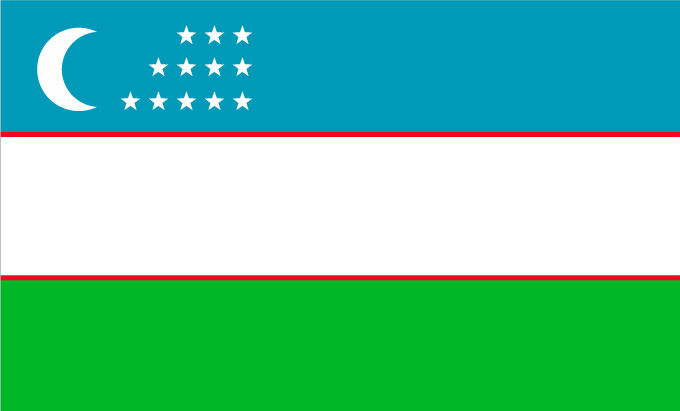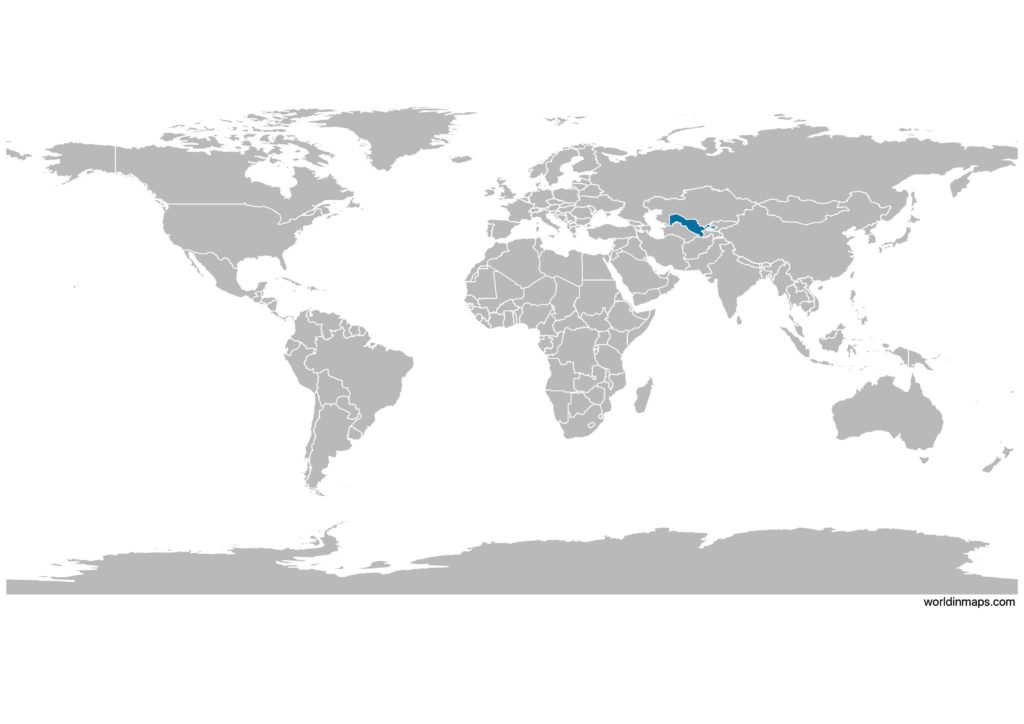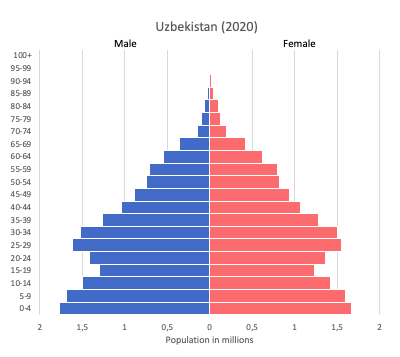Uzbekistan

| Government | |
| Name | Republic of Uzbekistan |
| Uzbek | Oʻzbekiston Respublikasi |
| Government type | presidential republic (highly authoritarian) |
| Capital | Tashkent (2,425,000) |
| Currency | Uzbek som (UZS) |
| Organization | |
| Member State | Commonwealth of Independent States (CIS) |
| People | |
| Population (2020) | 33,469,199 (41st) |
| Density of population | 74.1 P/km2 (132nd) |
| Nationality | Uzbekistani |
| Official languages | |
| Uzbek | |
| note: the Karakalpak language and Uzbek have official status in the autonomous Karakalpakstan Republic | |
| Ethnic groups (2017) | |
| Uzbek | 83.8% |
| Tajik | 4.8% |
| Kazakh | 2.5% |
| Russian | 2.3% |
| Karakalpak | 2.2% |
| Tatar | 1.5% |
| other | 4.4% |
| Religions | |
| Muslim (mostly Sunni) | 88% |
| Eastern Orthodox | 9% |
| other | 3% |
| Life expectancy (2020) | |
| Male | 71.7 years |
| Female | 78 years |
| Total population | 74.8 years (125th) |
| Homicides | |
| Total (2017) | 1.1 per 100,000 people (137th) |
| Geography | |
| Land area | 425,400 km2 |
| water area | 22,000 km2 |
| total area | 447,400 km2 (58th) |
| Lowest point | |
| Sariqamish Kuli | -12 m |
| Highest point | |
| Adelunga Toghi | 4,301 m |
| Land use (2011) | |
| Agricultural land | 62.6% |
| Arable land | 10.1% |
| Permanent crops | 0.8% |
| Permanent pasture | 51.7% |
| Forest | 7.7% |
| Other | 29.7% |
| Urbanization | |
| Urban population (2020) | 50.4% |
| Rate of urbanization | 1.28% annual rate of change (2015 – 2020) |
| Economy | |
| Labor force (2017) | 18.12 million (32nd) |
| Labor force by occupation (2012) | |
| Agriculture | 25.9% |
| Industry | 13.2% |
| Services | 60.9% |
| Unemployment rate (2017) | 5% (75th) |
| note: 20% are underemployed | |
| GDP (PPP) (estimate 2020) | |
| Total | $310,738 billion (55th) |
| Per capita | $9,595 (113th) |
| GDP (nominal) (estimate 2020) | |
| Total | $60.490 billion (78th) |
| Per capita | $1,831 (144th) |
| GDP by sector (estimate 2017) | |
| Agriculture | 17.9% |
| Industry | 33.7% |
| Services | 48.5% |
| Exports (2017) | $11.48 billion (84th) |
| Exports partners (2017) | |
| Switzerland | 38.7% |
| China | 15.5% |
| Russia | 10.7% |
| Turkey | 8.6% |
| Kazakhstan | 7.7% |
| Afghanistan | 4.7% |
| Imports (2017) | $11.42 billion (93rd) |
| Imports partners (2017) | |
| China | 23.7% |
| Russia | 22.5% |
| Kazakhstan | 10.7% |
| South Korea | 9.8% |
| Turkey | 5.8% |
| Germany | 5.6% |
Uzbekistan on the world map

Uzbekistan is located on the Asian continent and more specifically in the region of Central Asia.
Uzbekistan top 10 largest cities
- Tashkent (2,425,000)
- Namangan (597,000)
- Samarkand (530,000)
- Andijan (417,000)
- Nukus (310,000)
- Bukhara (285,000)
- Qarshi (260,000)
- Fergana (275,000)
- Kokand (240,000)
- Margilan (223,000)
Demography
Population pyramid

Age structure data
Estimate for 2020:
- 0-14 years: 23.19% (male 3,631,693/female 3,456,750)
- 15-24 years: 16.63% (male 2,601,803/female 2,481,826)
- 25-54 years: 45.68% (male 6,955,260/female 7,006,172)
- 55-64 years: 8.63% (male 1,245,035/female 1,392,263)
- 65 years and over: 5.87% (male 768,769/female 1,025,840)
Remark: the age structure of a population affects a nation’s key socioeconomic issues. Countries with young populations (high percentage under age 15) need to invest more in schools, while countries with older populations (high percentage ages 65 and over) need to invest more in the health sector. The age structure can also be used to help predict potential political issues. For example, the rapid growth of a young adult population unable to find employment can lead to unrest.
Population from 1950 to 2020
Source: United Nations, Department of Economic and Social Affairs, Population Division (2019). World Population Prospects 2019, Online Edition. Rev. 1.
Evolution of the life expectancy from 1960 to 2018
Source: World Development Indicators, The World Bank
Economy
Agriculture:
cotton, vegetables, fruits, grain; livestock
Industries:
textiles, food processing, machine building, metallurgy, mining, hydrocarbon extraction, chemicals
Exports – commodities:
energy products, cotton, gold, mineral fertilizers, ferrous and nonferrous metals, textiles, foodstuffs, machinery, automobiles
Imports – commodities:
machinery and equipment, foodstuffs, chemicals, ferrous and nonferrous metals
Time zone and current time in Uzbekistan
Go to our interactive map to get the current time in Uzbekistan
Historical region
- Uzbekistan was known by European from the Middle age to the 20th century as making part of Tartary.